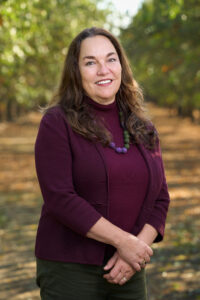Almond Board Directors and CEO listen and talk with industry on 8-stop tour
Courtesy of the Almond Board of California
The informal settings encouraged deep conversations, honest questions and shared ideas.
The Almond Board of California Board of Directors and President and CEO Clarice Turner engaged almond industry members up and down the Central Valley in an eight-stop listening tour to answer questions and hear concerns and ideas.
Board members and Turner hosted gatherings starting in Shafter in the south valley and ending in Orland in the north to hear what growers and handlers have on their minds and to give people a chance to ask questions in informal settings.
“While the long-term outlook for the industry seems promising, the short-term economics have left many growers contemplating their next steps,” said Alexi Rodriguez, chair of ABC’s Board of Directors. “The listening sessions were a great opportunity to engage with industry members to share information, experiences and ideas. It was also great for Clarice to hear from stakeholders in each region, as their challenges and priorities vary. Unfortunately, the Almond Board can’t solve every problem and many will be left to make some tough decisions going forward. That said, the Board and the organization are working hard to tackle the areas where we can make a positive difference for the future of the industry.”
The listening sessions were casual and designed to be small so the questions and conversations could go deep. They are one of the ways Turner, who started as ABC president and CEO in September, is introducing herself to the industry and learning more about the people in the industry she serves.
“I enjoyed meeting so many interesting, caring and knowledgeable people across the valley,” Turner said. “I heard many stories and learned so much about the history of this great industry, people’s hopes and concerns, and about their commitment to their land, roots, communities and to almonds. Despite the current difficult macro environment, we had very constructive conversations about the future of the industry. It was an inspiring week.”
Subjects ranged from broad policy to technical questions, and the conversations will help guide sessions at The Almond Conference 2023 in Sacramento Dec. 5-7 where topics and issues will be addressed by experts during in-depth panel discussions. Rodriguez, Turner and Board of Directors members will also be available at The Almond Conference for industry members who have questions of their own.















